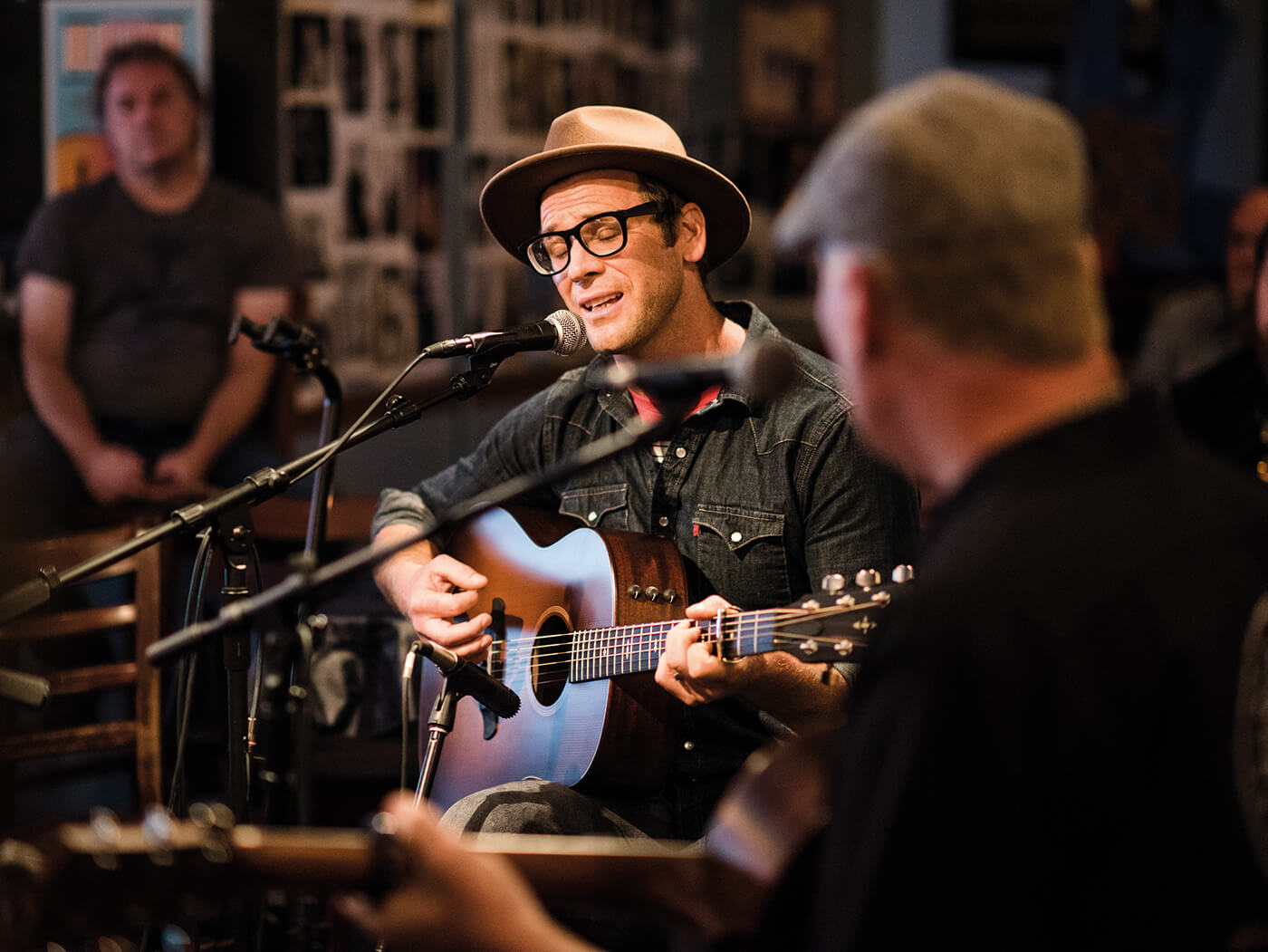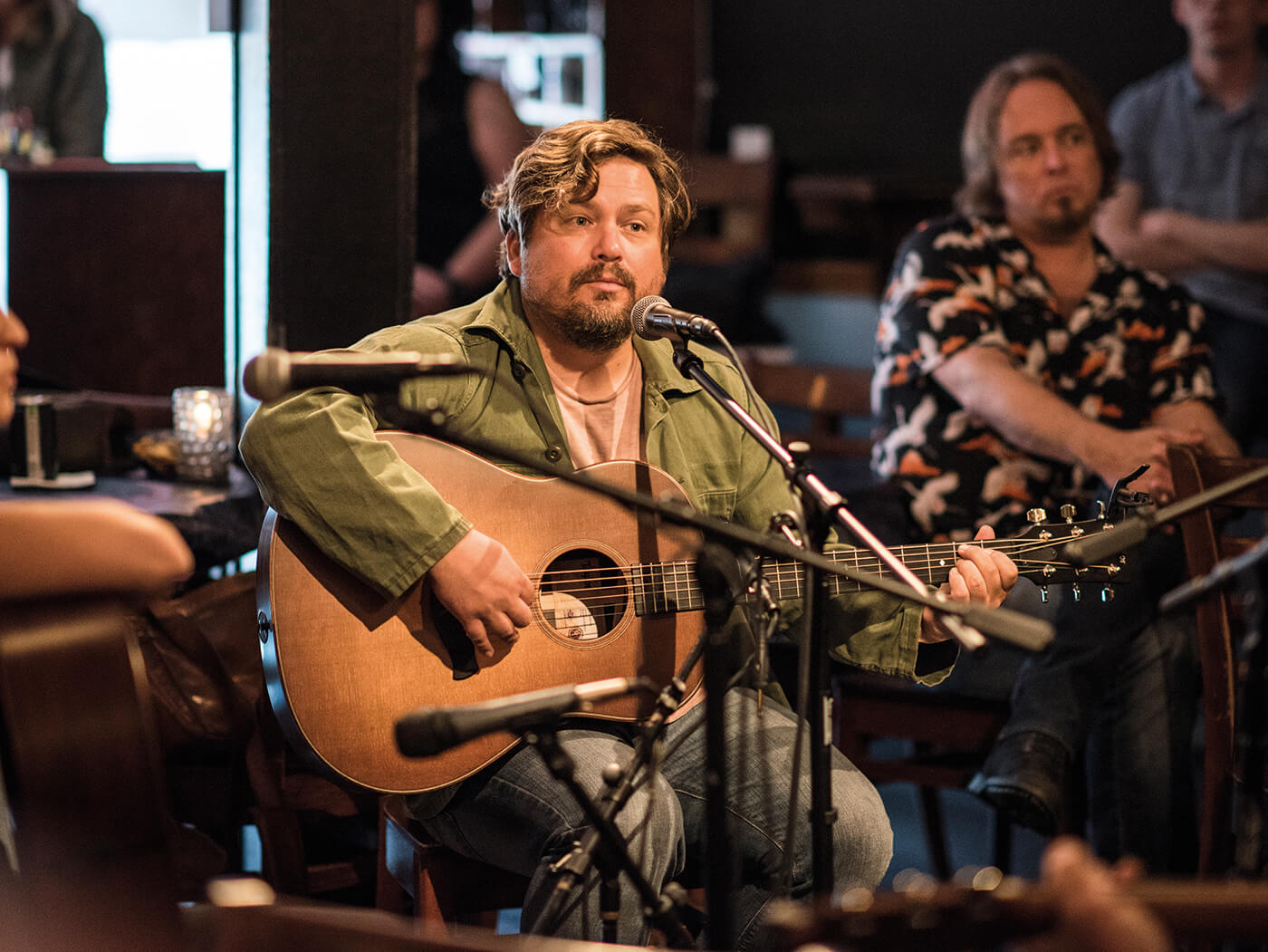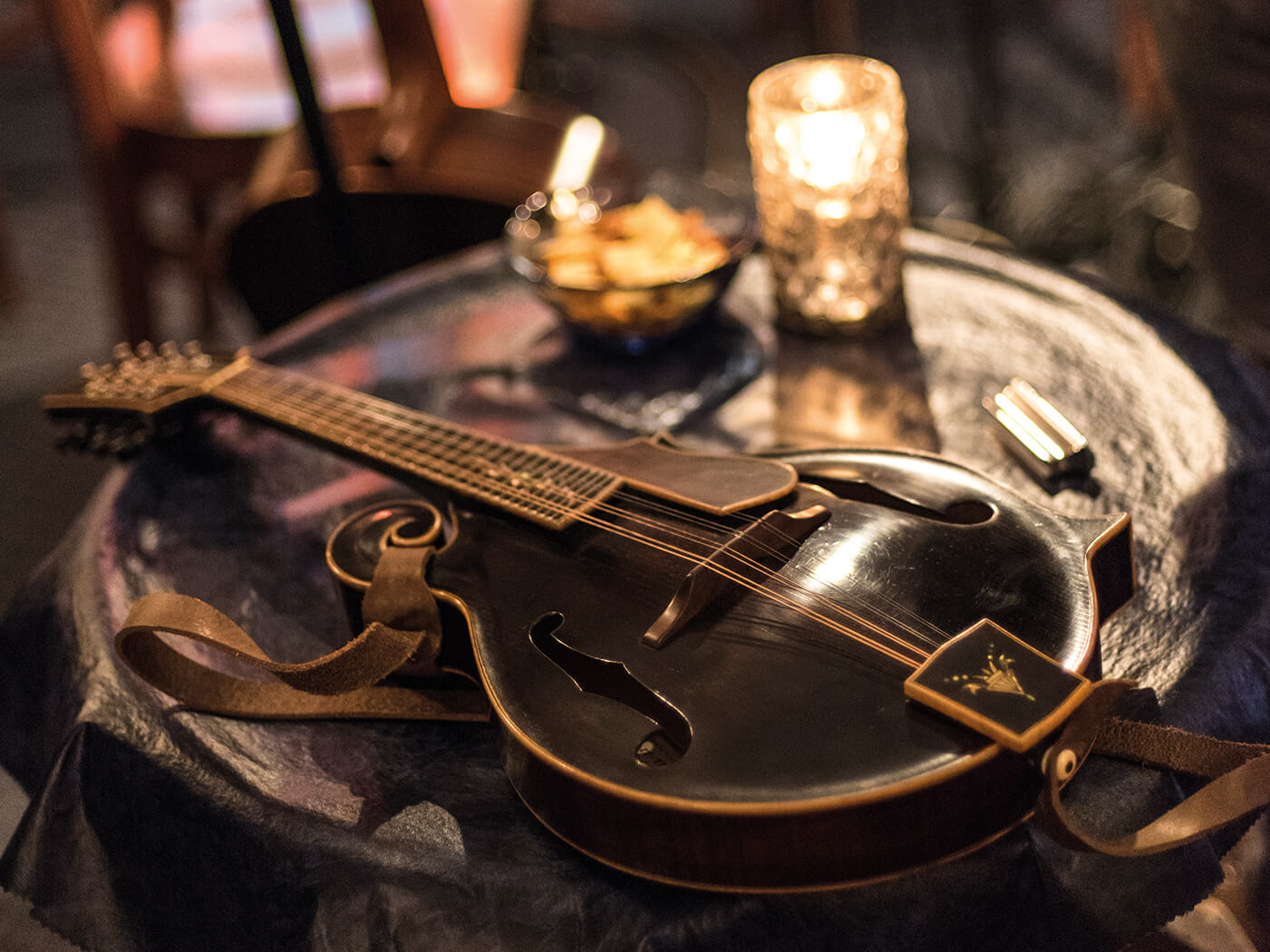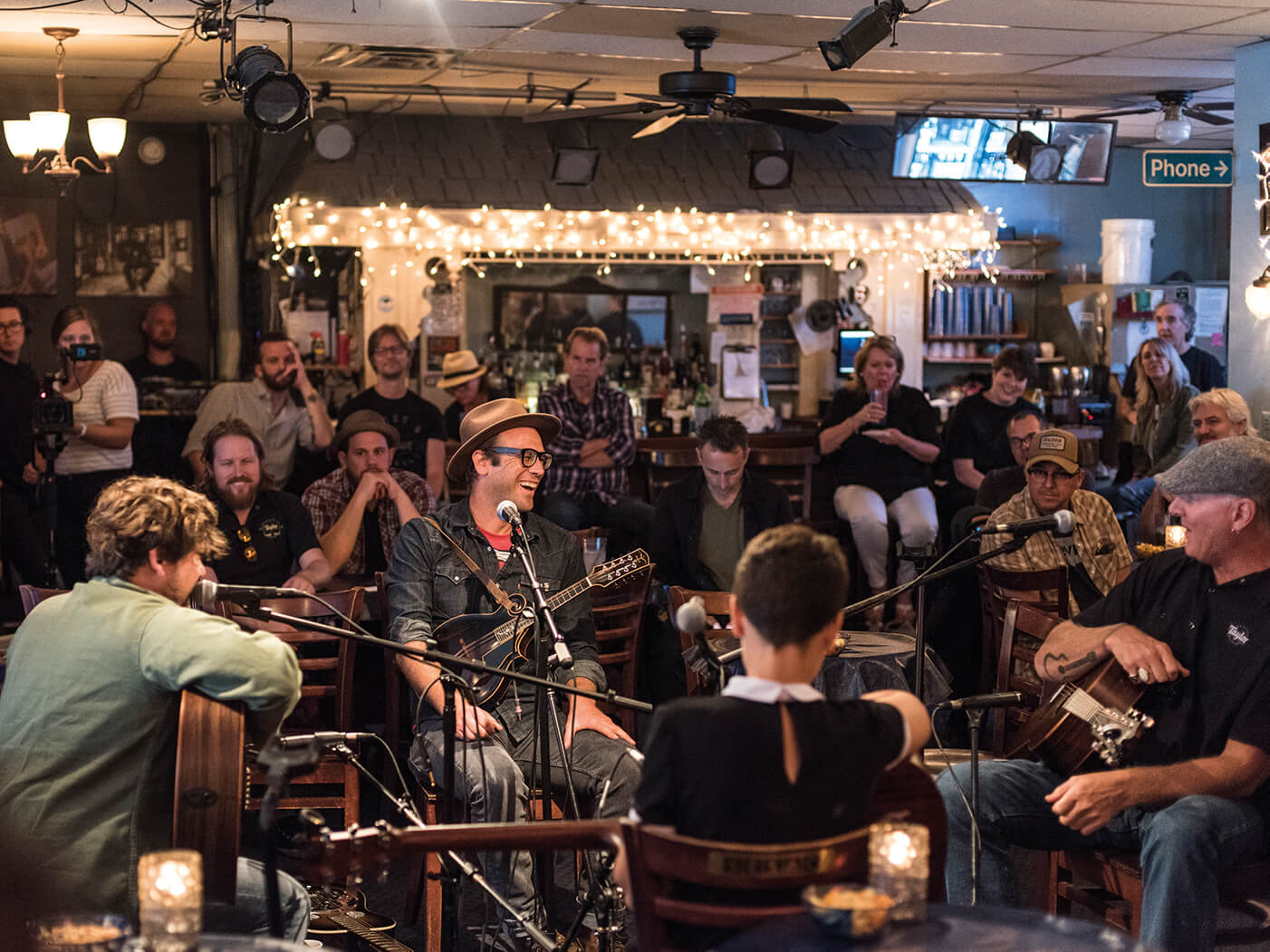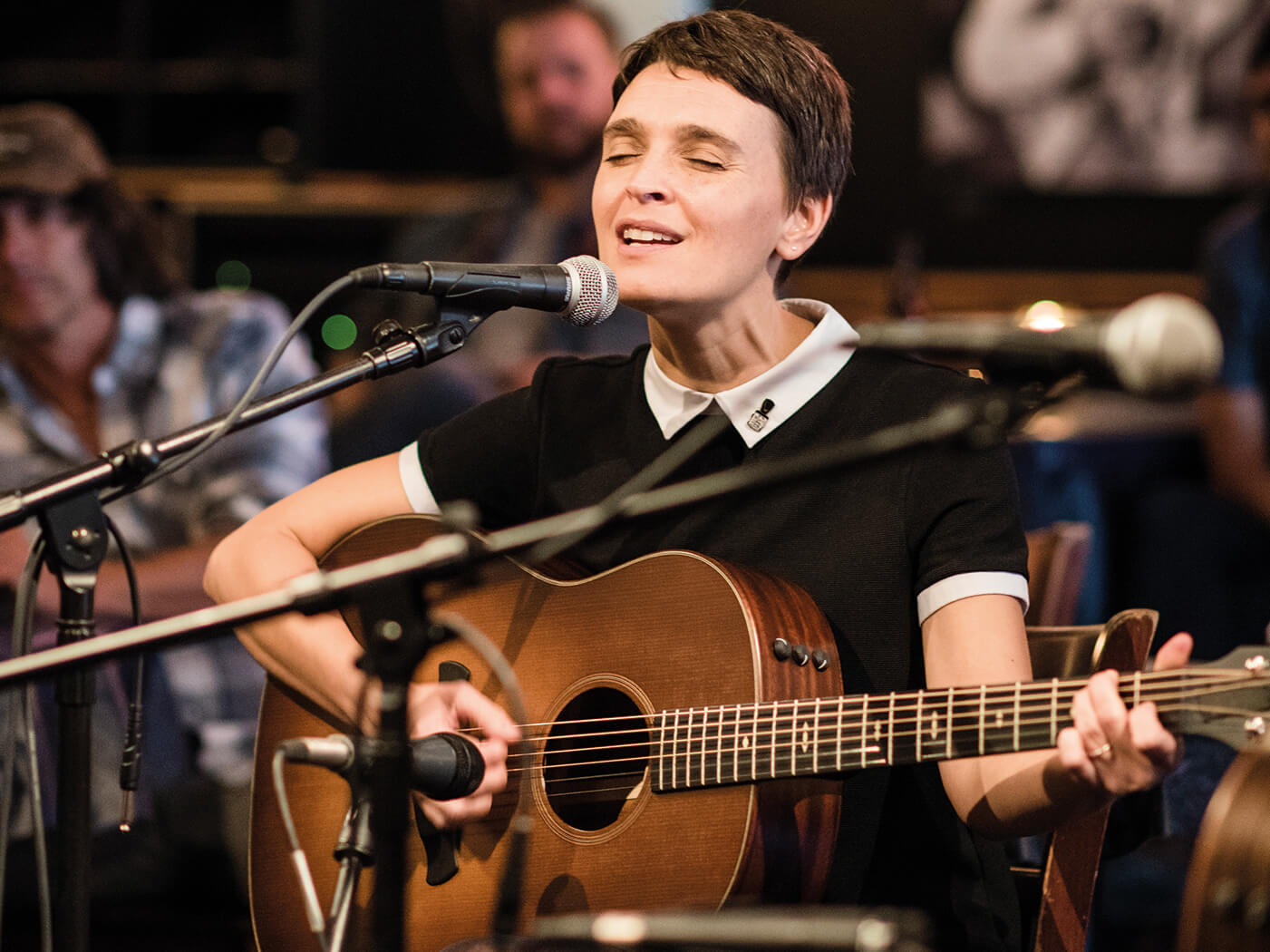Related Tags
Interview: Andy Powers dives deep into the Grand Pacific
Last year’s V-Class launch saw Taylor’s master guitar designer Andy Powers reinvent the internal architecture of the flat-top acoustic with breathtaking implications for projection, sustain and tuning. For 2019, Powers is ready to challenge your preconceptions about what a Taylor guitar is supposed to sound like. We head to Nashville to meet the company’s new round-shoulder dreadnought, the Grand Pacific…
In late 2017, when Taylor Guitars wanted to show a small group of guitar journalists its latest innovation, the company chose Carlsbad, a 35-minute drive north of downtown San Diego and home to Andy Powers, the master luthier and polymath to whom the creative torch has been passed from Bob Taylor himself. Bob’s concerns now stretch way into the future as he immerses himself in sustainability projects separated by over 10,000 miles in Hawaii and Cameroon. And while Bob devotes his time to ensuring there’s wood for tomorrow, Andy works with the timber of today to design the finest instruments in the company’s 45-year history.
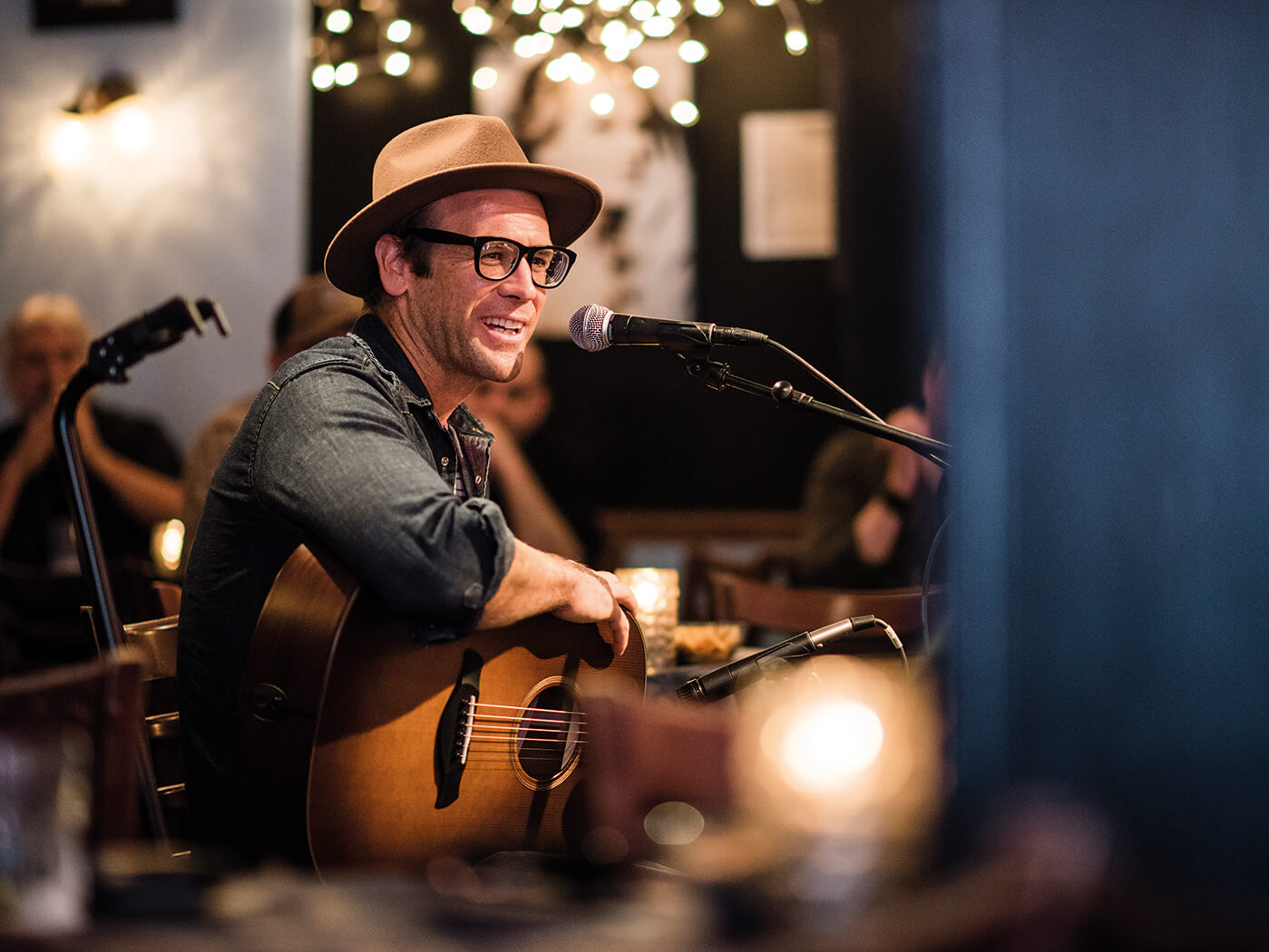
The airy barn that houses Andy’s home workshop was the perfect environment in which to introduce the V-Class system. Within earshot of the surf that Powers was staring into when he experienced the Damascene moment that inspired his revolutionary bracing system, we heard its exceptional projection and sustain – and truly remarkable intonation – for the very first time.
Yet although the modernistic and ornate Builder’s Edition K14ce was chosen as the instrument in which V-Class bracing would make its debut, it wasn’t the first guitar that Powers had in mind when he set about reworking the internal architecture of the flat-top acoustic guitar a couple of years earlier. Even as people were being wowed by the K14ce in the packed Taylor booth at the Winter NAMM Show in January 2018, in a side room away from flashbulbs and live-streaming video, a handful of people were shown a slope-shoulder prototype that was a very different guitar indeed.
Fast-forward to September 2018, and that guitar had a name. In short, if you think you aren’t a fan of ‘the Taylor sound’, don’t close the tab just yet. While the cutaway-equipped Builder’s Edition K14ce Grand Auditorium is Taylor in excelsis, the Grand Pacific has been crafted with an affinity for the crackle of vinyl records and an appreciation for an altogether older and more elusive steel-string acoustic sound.
Pacific railroad
Although the ocean features in the Grand Pacific’s name, Taylor Guitars chose to fly four hours east to Tennessee to unveil its new body shape to the guitar press in the Zac Brown Band’s Southern Ground recording studio in Nashville. A city where songs have long been currency makes perfect sense as a location when Andy begins to explain how he arrived at this new take on the round-shoulder dreadnought format.

“I thought, well, there’s all these sounds that I’m familiar with, that I love,” Powers recalls. “I hear them on old records, I hear them on the music I grew up with – country-rock from Laurel Canyon and bluegrass. My dad, being a carpenter, would listen to bluegrass and country music all day long. You knew you could go through about four records between a morning, coffee break and lunchtime, you get through five in the afternoon. It paces you well, it accompanies you, it’s a way to get through your life. So I grew up with this kind of music in our house, and working with my dad. I’ve dug more than my fair share of ditches listening to the The Louvin Brothers!
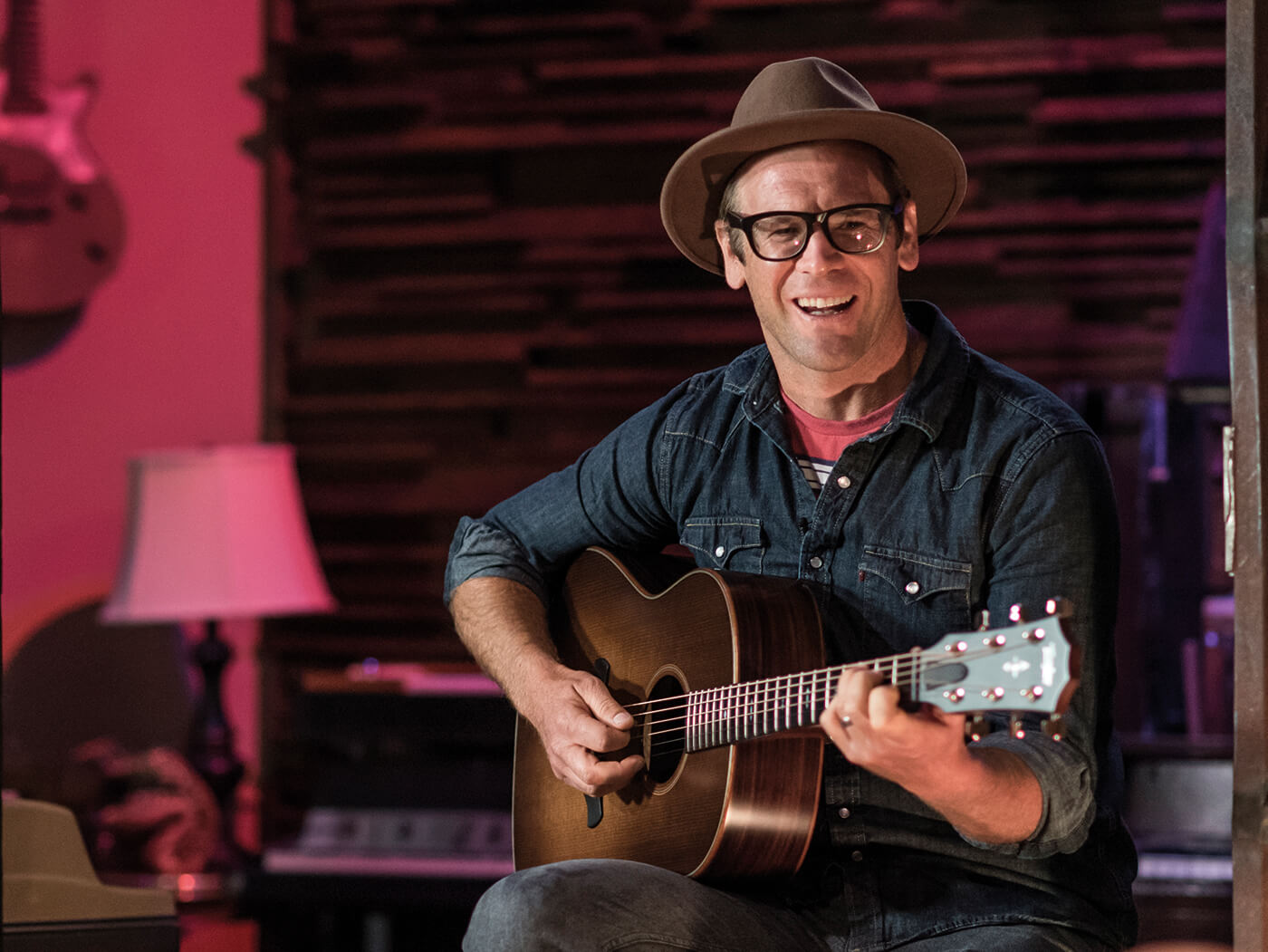
“So when I think about those songs, and listen to those sounds… in reality, I can’t actually make those sounds with any of the guitars we have around. Even with many of the old guitars, it doesn’t make the sound that we’re familiar with because oftentimes, that’s had some of its issues dealt with. It’s like a composite sound. The sound of a guitar filtered through a microphone, with EQ, onto tape, onto a record. So I’m listening to these songs and these wonderful stories and thinking, I need a guitar that will make this sound. I should build a guitar that makes those kind of flavours.”
Natty dread
And build a guitar he did. Taylor’s vice president of marketing Tim O’Brien jokes that they “spent a year debating” whether the Grand Pacific is a dreadnought or not. “It’s about the size of a dreadnought,” says Andy. “It’s kind of shared in that bloodline, if you squint your eyes just right! But it really is a type of guitar that hasn’t really existed before in this way. So it’s loosely a slope-shouldered guitar.
“I designed this instrument using the V-Class architecture,” Powers continues, “and it has all the attributes that we love about that – it has the volume and the sustain and this incredible intonation, a really nice playing action and everything – but it has a totally different character than the Grand Auditorium guitars that we built using that system. It’s a whole different personality. It has, in some ways, a more mature voice in the way that it articulates each note. Now a modern GA, that’s a great guitar. I love the way it sounds, it has a real vibrant precision. But this guitar has a warmth and clarity that I only find with kind of a more seasoned guitar.”
The elegant simplicity and symmetry of the Grand Pacific body shape immediately lends the instrument more of a blue-collar vibe than many high-end Taylors. Although it’s now standard on all of Taylor’s El Cajon-made Grand Auditorium models, V-Class bracing debuted on one Builder’s Edition instrument with a five-grand price tag. The Grand Pacific body shape has been made more accessible from day one by including the sapele/spruce 317 (from £1,919) alongside a pair of Builder’s Editions – the mahogany/torrefied Sitka spruce 517 (from £2,999) and the rosewood/torrefied Sitka spruce 717 (from £3,179).
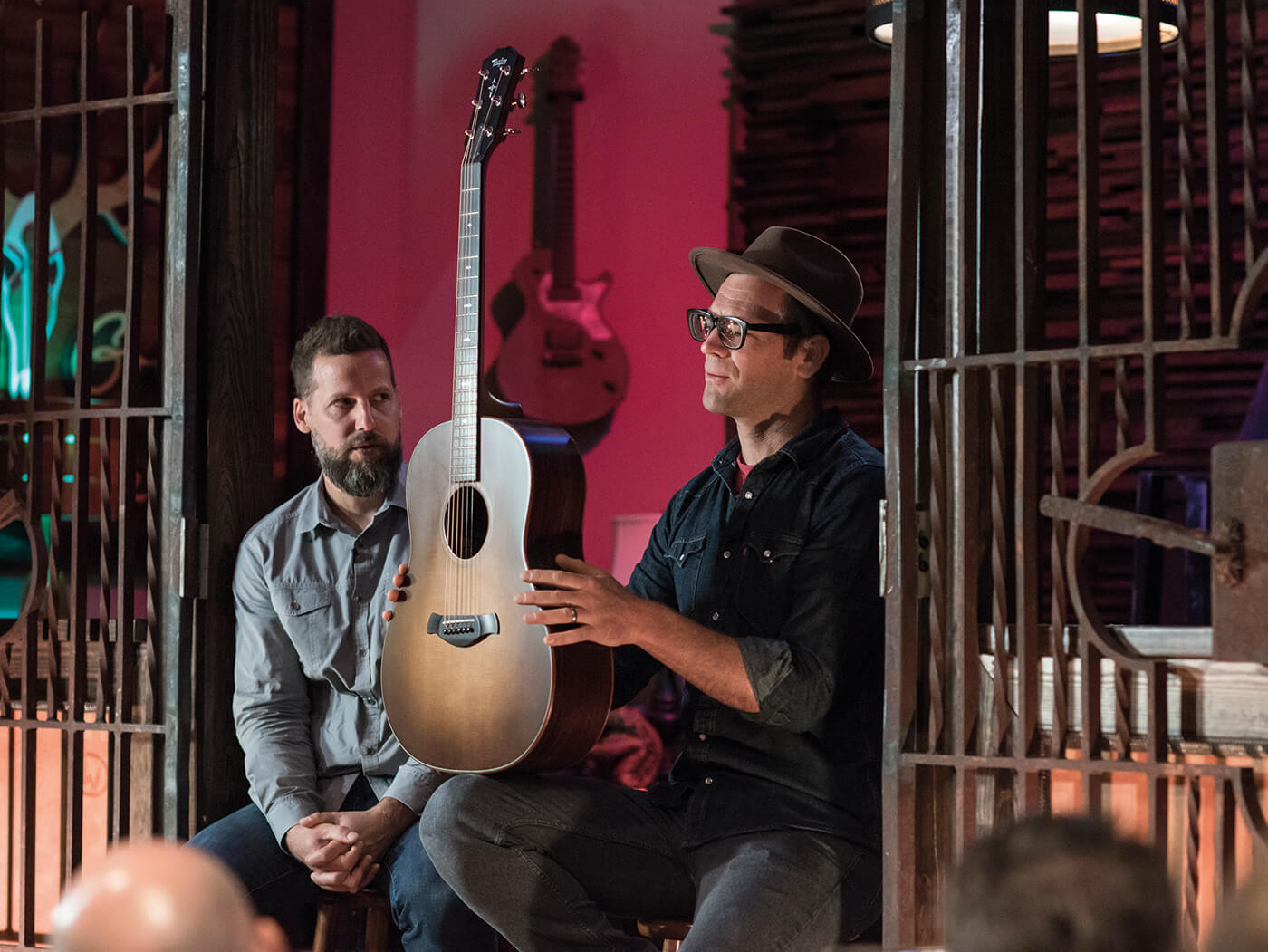
In a move Andy calls “pretty fresh for us”, the Builder’s Edition Grand Pacifics feature a new, compound neck profile that transitions from a soft V at the nut to a rounded C with a ridgeless heel. “When I look at the way I hold a guitar and the way that people play [in lower registers], I tend to wrap my hand a little more and the thumb goes around the neck,” Andy notes. “But by the time I’m up here [in higher registers] on the fingerboard, it doesn’t do that anymore. So we built a neck carve that actually transitions from one profile into another to get a little more friendly and familiar for a player.”
Not a new idea, but certainly one that’s new to Taylor. This player-friendliness continues, with radiused edges a continuing theme throughout Powers’ Builder’s Edition designs: “Combined with this rolled fingerboard edge, and these different kind of softened, rounded off corners,” he reflects, “it just builds this guitar that’s so comfortable and so approachable, for a whole lot of different playing styles.”
Problem solving
The V-Class bracing system isn’t just about making an acoustic guitar shout louder and longer, it can also be used for control, and in this case, to tame some of the less-desirable characteristics associated with a particular body shape. While a dreadnought delivers more bass and bottom-end thump than a narrower-waisted design, this can often manifest itself as an overpowering plosive that causes problems for sound engineers. “A typical dreadnought builds low-end emphasis at the expense of the middle- and high-register notes,” says Andy.
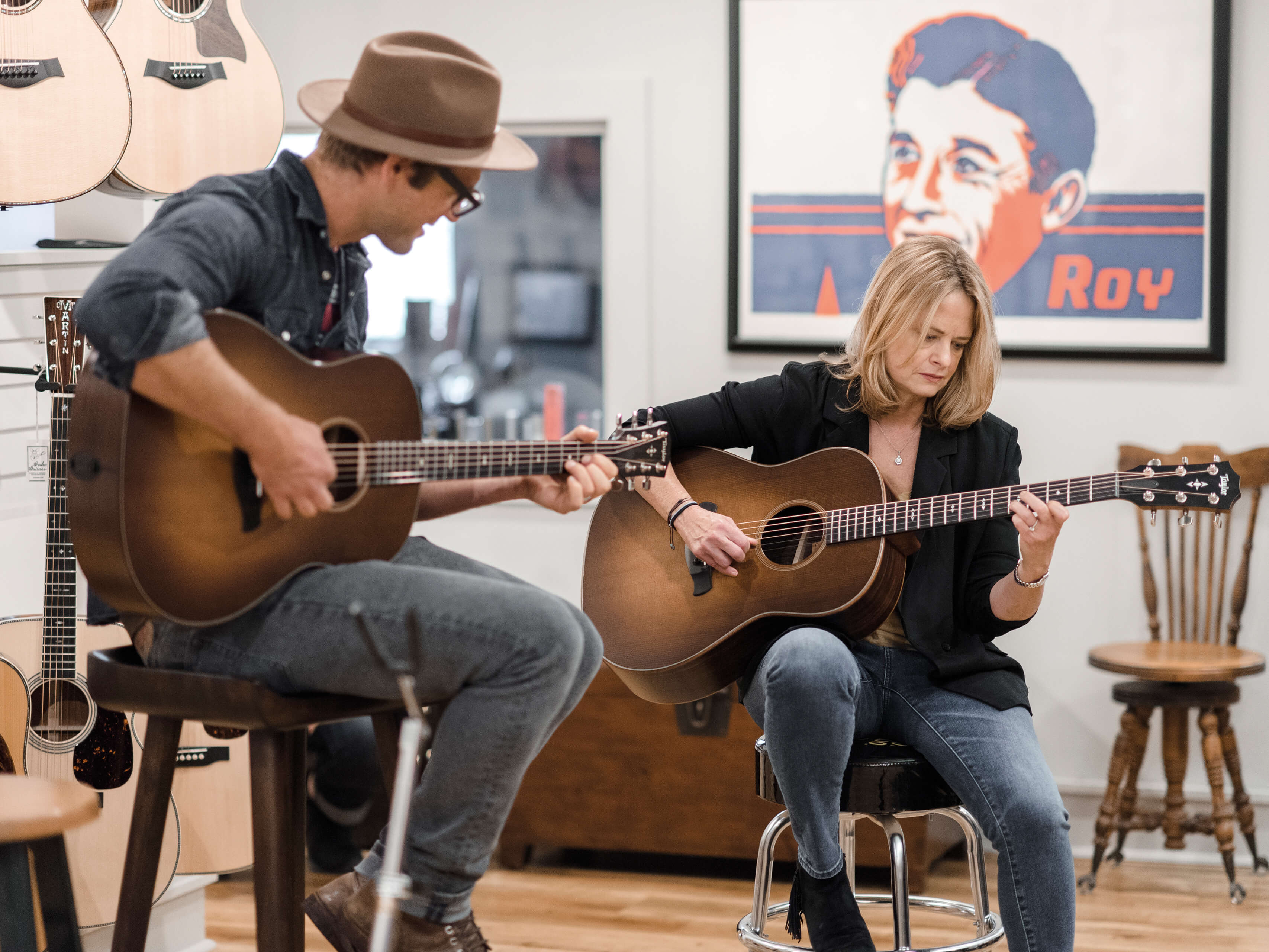
“As a result, this body resonance effectively swallows up all the other notes, preventing the body from responding to them. The Grand Pacific body, powered by the V-Class architecture, generates low-end power without taking anything away from the rest of the register. You get smooth and warmly powerful notes, with consistency across the frequency spectrum.”
The result is a guitar that delivers warmth and familiarity without getting swamped by bass, and retains clarity without the more clinical-sounding precision of a Grand Auditorium. It’s a sound that immediately proves popular with the assembled journalists in the fabulous live room at Southern Ground, where even the figured koa flooring was supplied by Taylor, repurposed from seconds deemed unsuitable for guitars. In an impromptu acoustic jam, we notice the contrast between the 517’s mahogany and 717’s rosewood back and sides provides two distinct accents in the Grand Pacific’s vocabulary. With the drier-toned mahogany guitar taking the lead role and the rosewood the rhythm, it’s a particularly pleasing combination.
Candy store
After spending some time with the guitars at Southern Ground, we head a couple of miles south to the legendary Gruhn Guitars store, where Grammy-winning banjo player/guitarist/producer Alison Brown ably assists Andy in demonstrating the Grand Pacific in the context of a series of duo performances. “The guitar felt so alive it felt like it was going to jump out of my hands,” says Brown of her first encounter with a V-Class Taylor.
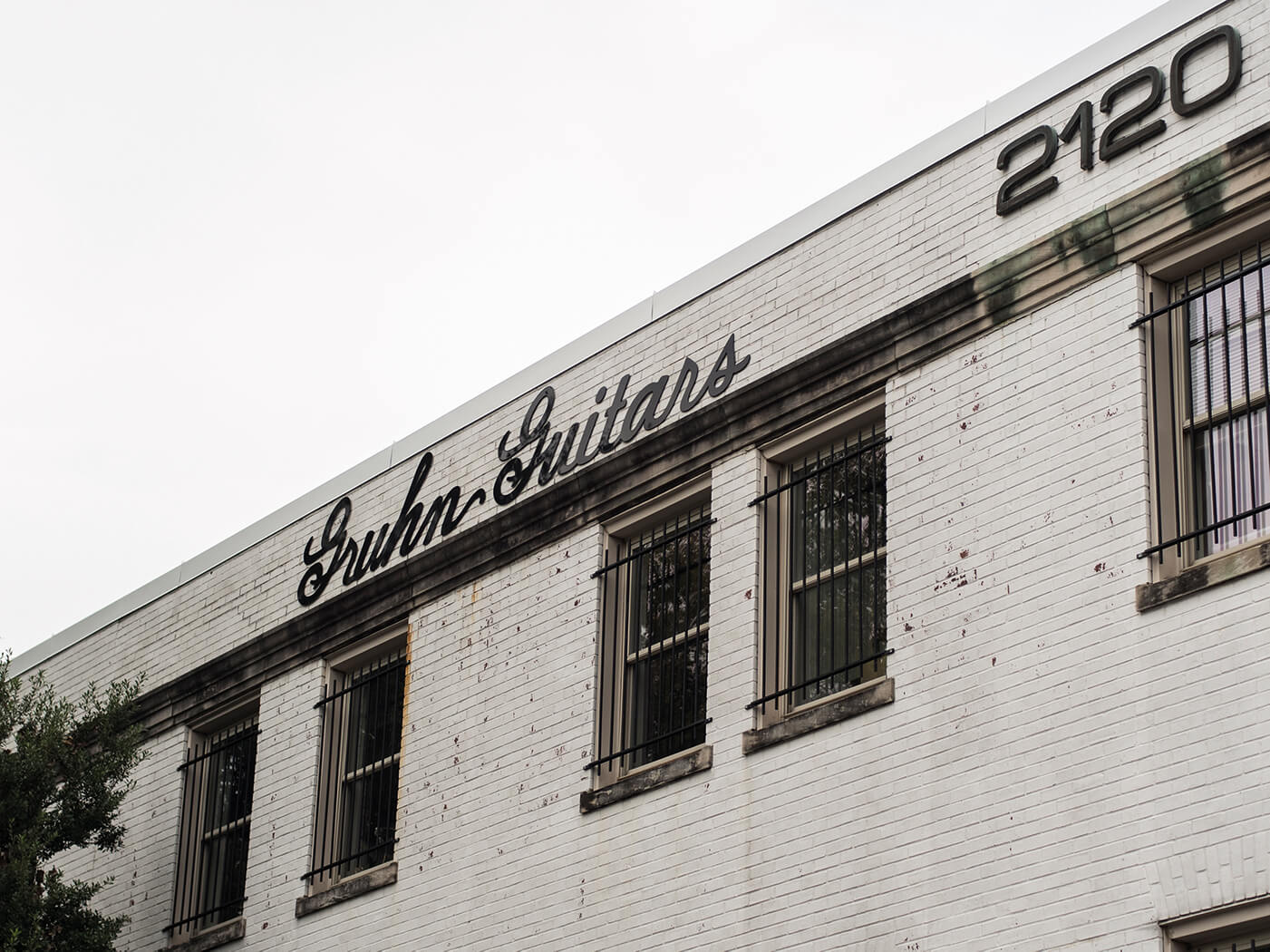
Powers describes George Gruhn as “one of the patron saints of guitar”, and the famed guitar dealer and historian is a fan of Andy’s work. Gruhn’s unique taxonomical approach to categorising the instrument came from a passion for zoology; his doctorate in the psychology of animal behaviour at the University Of Tennessee was abandoned when Hank Williams Jr came calling in early 1969, having heard that the young student had lots of old Martin guitars.
“It’s not simply about old instruments,” says Gruhn, “because what makes an instrument good is not simply whether it’s old, or rare. My father was a pathologist and there are plenty of stories about him being delighted when making an extremely interesting diagnosis, but often, this diagnosis was not good news for the patient! In general, instruments that are extraordinarily rare are rare for a reason. It was a commercial failure, at least when it was it new. Even some fabulously good instruments were commercial failures when new.
“The quality of new guitars being made today is better than it was when I opened up my store. And that was 48-and-a-half years ago. I think Taylor’s making the best guitars they’ve ever made in the history of the company. These are by far the finest Taylors I’ve ever heard. They are also some of the finest new guitars I’ve ever played. They are right on up there with some custom luthier-built instruments that are $20,000 plus. And some of those luthier-built guitars I’d view as fine pieces of furniture. These are fine musical instruments and they are more musical-sounding than most. They are very special – they are as versatile as any acoustic guitar I’ve played.”

On Andy specifically, George is similarly complimentary: “I’m impressed with the depth of knowledge that Andy has. We were able to talk about harpsichords and violins and mandolins and viola da gambas and lutes and virtually anything else… he knew them, and he understood what makes them tick and the history of these instruments. When it comes right down to it, what makes a guitar good is not how old it is, it’s first and foremost the design.
“Without a good design, it doesn’t matter how good the workmanship or the materials are. It’s like being up in an airplane. If you’re 40,000 feet up in the air and it has a bad aerodynamic design – it can be made from wonderful materials, it can have great workmanship, gold-plated fixtures, mahogany panelling – you’ll die. Workmanship is very important. With a good design and bad workmanship that is structurally unstable, the design will fail. But good design is first and foremost. It has to have good structural workmanship, and materials do matter.”
Addressing Powers directly, Gruhn says: “You understand design. You understand all of those aspects and how to do it in a factory setting in quantity. But you also understand the tradition, how we got here, what does work and the pathology of old instruments. So you know what fails. If you see the patterns repeatedly… you stop doing that! You don’t have to do everything in the way it was done 50 or 100 years ago, if you see things that consistently fail.
“When you are designing a new guitar you can look at all the evolutionary history and you can see which organ systems fail at what point. We don’t use the same kind of plastic that we know rots… and that’s why all those 60s Gretsches need rebinding. And now even D’Aquistos do. So you don’t do that. You have a wealth of knowledge that you are actually applying.
“I see a lot of things on these new Taylor guitars that I haven’t seen on any vintage guitar. The V bracing is new, and it’s fascinating to hear the intonation that you get on these when there’s nothing about the nut that would affect intonation, nothing about the fret scale that would affect intonation, nothing about the bridge saddle or bridge design. But to the brain, it processes that as ‘this intonates differently’. And all those discordant chords that you can demonstrate on other guitars, played on this, the bracing pattern makes it sound in tune. There’s no harmonic resonances that are fighting each other. I think you have achieved something that I haven’t heard before on a flat-top guitar.”
In the round
Later, we head from Gruhn Guitars to Nashville’s legendary Bluebird Cafe, the intimate 90-seater venue where Garth Brooks was signed after a showcase performance in 1987 and where the likes of Taylor Swift, Keith Urban and a host of Nashville’s biggest stars have appeared over the years. Inside, we’re treated to an in-the-round performance hosted by Andy Powers alongside Nickel Creek’s Sean Watkins, singer-songwriter Sarah Masen and former Taylor product-specialist-turned-solo-artist Michael Lille. When not taking the lead role, Andy effortlessly sits in on mandolin and slide to provide accompaniment. The feelgood atmosphere sees songs punctuated by stories and laughter and it’s precisely this kind of warmth Powers sought to evoke when designing the Grand Pacific.
By the end of a long and enjoyable day, first impressions suggest the Grand Pacific might just be that elusive best-of-both-worlds flat-top. With all of the benefits of a modern Taylor – precision manufacture, tuning stability and environmentally conscious materials – the Grand Pacific’s sound has a warmer, less crystalline hue and more of an old-time drawl in its voice. We’d call that a job well done.
Read our review of all three of Taylor’s new-for-2019 Grand Pacific instruments here.

